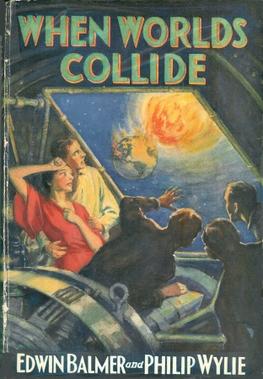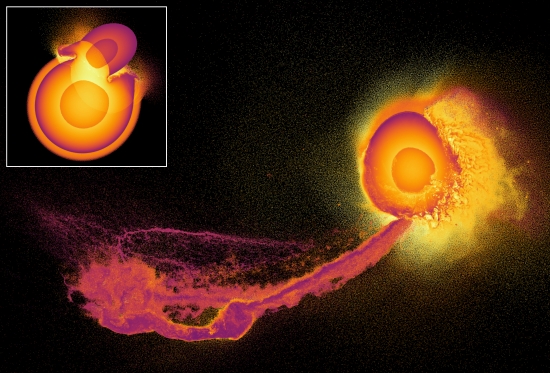What happens when worlds collide? The question recalls the novel by Philip Wylie and Edwin Balmer, which appeared as a serial in Blue Book magazine beginning in 1932 and concluded the following year. The book version of When Worlds Collide appeared in 1933, and the movie, directed by Rudolph Maté, came out in 1951 in a George Pal production. I would wager that most Centauri Dreams readers have seen it.

Let’s hope we never share such a fate, but it’s likely that collisions are commonplace in the late stages of planet formation, and many researchers believe that Earth’s Moon was the result of the collision of our planet with a Mars-sized planet about 4.5 billion years ago. Scientists at Durham University and the University of Glasgow have recently developed computer simulations tracking atmosphere loss during such collisions using the COSMA supercomputer, which is part of the DiRAC High-Performance Computing facility in Durham.
The work involves smoothed particle hydrodynamics (SPH) simulations to model giant impacts. The planets are modeled as digital ‘particles’ and run through a process of evolution under different conditions of gravity and pressure. This work appears to be the first time the erosion of thin atmospheres has been studied with full 3D, high-resolution simulations of giant impacts at various impact angles and speeds, injecting a range of atmospheric masses for the proto-Earth. The work takes advantage of a program called SWIFT to model hydrodynamics and gravity.
We can get a look at the results in a new paper in the Astrophysical Journal. The authors have created cross-section animations of the early stages of such collisions, modeling not only head-on strikes but grazing impacts like the one thought to have produced our Moon. They likewise model fast as well as slow giant impacts using 100 million particles. As you can see in the image below, these are color-coded for material as well as internal energy.

Image: Still image cross-section showing the impact (inset) and aftermath (main picture) of a 3D simulation of a giant planetary impact using 100 million particles, coloured by their internal energy, similar to their temperature. Credit: Dr Jacob Kegerreis, Durham University.
Jacob Kegerreis (Durham University) places the work in context:
“We know that planetary collisions can have a dramatic effect on a planet’s atmosphere, but this is the first time we’ve been able to study the wide varieties of these violent events in detail. In spite of the remarkably diverse consequences that can come from different impact angles and speeds, we’ve found a simple way to predict how much atmosphere would be lost. This lays the groundwork to be able to predict the atmospheric erosion from any giant impact, which would feed into models of planet formation as a whole. This in turn will help us to understand both the Earth’s history as a habitable planet and the evolution of exoplanets around other stars.”
We learn that the type of impact tells the tale in terms of how much atmosphere is lost. Higher-speed and/or head-on impacts create the greatest atmospheric loss, sometimes completely destroying not just the atmosphere but parts of the planet’s mantle layer beneath the crust. Earth’s likely grazing impact is the kind that disrupts but does not destroy the atmosphere. What actually happened on Earth during this period is not known, but the researchers believe our planet lost somewhere between 10 and 50 percent of the atmosphere.
Atmospheric survival is not assured in the early planet-forming environment, a time when planetary embryos collide after their accretion from a proto-planetary disk. To acquire an atmosphere, planets accrete gases from surrounding materials as well as from impacting volatiles, eventually outgassing volatiles from within. That means an infant rocky world must deal with not only the radiation pressure of its star but small and large impacts. In the case of Earth, we have Moon-formation scenarios but little information about the proto-Earth’s crust, ocean or atmosphere. Consider the evidence from early Solar System materials:
Focusing on the atmosphere, the Earth’s volatile abundances are remarkably different from those of chondrites (Halliday 2013), which act as a record of the condensable components of the early Solar System. Specifically, nitrogen and carbon are depleted compared with hydrogen, which could be explained by the loss of N2 and CO2 with an eroded atmosphere while retaining H2O in an ocean (Sakuraba et al. 2019). Unlike the abundances, the isotope ratios match those of primordial chondrites. Hydrodynamic escape – driven by XUV radiation from the star or heat from the planet below – preferentially removes lighter isotopes, while impacts remove bulk volumes of atmosphere. This suggests that impacts (not necessarily giant ones) are the primary loss mechanism, driving fractionation by removing more atmosphere than ocean while preserving isotope ratios…
Interestingly, there is at least one paper positing two occasions where Earth lost its atmosphere based on the relative abundances of helium and neon in mantle reservoirs of different ages. If giant impacts are relatively common, this would ensure that exoplanets in mass ranges between Earth and Neptune would show wide variation in atmospheric masses. Impacts, in other words, take precedence over irradiation and photoevaporation, according to the authors.
In Earth’s case, the ‘big whack’ that created the Moon may have been only part of the story:
…only around 10% of the atmosphere would have been lost from the immediate effects of the collision. This suggests that the canonical impact itself cannot single-handedly explain the discrepancies between the volatile abundances of the Earth and chondrites by eroding the early atmosphere, compared with alternative, more-violent Moon-forming scenarios. However, the caveat of ‘immediate’ erosion is important, because we have here only considered the direct, dynamical consequences of a giant impact.
The paper goes on to point to the thermal effects of such an impact, producing significant atmosphere erosion. Interestingly, the presence of an ocean can enhance atmosphere loss, creating the higher figure of 50 percent loss mentioned earlier. This work makes it clear how little we know about atmospheric loss, but it does produce a scaling law for total atmospheric erosion for a variety of scenarios involving Mars-sized impactors.
Promising targets for future study include: investigations of different impactor and target masses; extensions to both more massive and even thinner atmospheres; the inclusion of an atmosphere on the impactor as well as the target; and testing the dependence on the planets’ materials, internal structures, and rotation rates. This way, robust scaling laws could be built up to cover the full range of relevant scenarios in both our solar system and exoplanet systems for the loss and delivery of volatiles by giant impacts.
The paper is Kegerreis et al., “Atmospheric Erosion by Giant Impacts onto Terrestrial Planets,” Astrophysical Journal Vol. 897, No. 2 (15 July 2020). Abstract / preprint.



Interesting. I would have thought that a violent collision like that would result in a ball of lava, with no chance of retaining a liquid ocean. Yet, they seem to be saying the ocean remains.
I am awaiting, tongue in cheek, for a Velikowsky (“Worlds in Collision” etc.) reference to surface in these comments. Oops!
Don’t Lars hope. Somevon will Trier it.
The Formation of Jupiter’s Diluted Core by a Giant Impact.
“The Juno mission has provided an accurate determination of Jupiter’s gravitational field, which has been used to obtain information about the planet’s composition and internal structure. Several models of Jupiter’s structure that fit the probe’s data suggest that the planet has a diluted core, with a total heavy-element mass ranging from ten to a few tens of Earth masses (~5-15 % of the Jovian mass), and that heavy elements (elements other than H and He) are distributed within a region extending to nearly half of Jupiter’s radius. Planet-formation models indicate that most heavy elements are accreted during the early stages of a planet’s formation to create a relatively compact core and that almost no solids are accreted during subsequent runaway gas accretion. Jupiter’s diluted core, combined with its possible high heavy-element enrichment, thus challenges standard planet-formation theory. A possible explanation is erosion of the initially compact heavy-element core, but the efficiency of such erosion is uncertain and depends on both the immiscibility of heavy materials in metallic hydrogen and on convective mixing as the planet evolves. Another mechanism that can explain this structure is planetesimal enrichment and vaporization during the formation process, although relevant models typically cannot produce an extended diluted core. Here we show that a sufficiently energetic head-on collision (giant impact) between a large planetary embryo and the proto-Jupiter could have shattered its primordial compact core and mixed the heavy elements with the inner envelope. Models of such a scenario lead to an internal structure that is consistent with a diluted core, persisting over billions of years. We suggest that collisions were common in the young Solar system and that a similar event may have also occurred for Saturn, contributing to the structural differences between Jupiter and Saturn.”
https://arxiv.org/abs/2007.08338
The Earth and the rest of the inner terrestrial planets plus the asteroid belt between Mars and Jupiter were what resulted from this impact. ;-{
In 2015, scientists found evidence for life on Earth from 4.1 billion years ago. Earth itself formed 4.6 billion years ago.
So it would seem life took ahold quite soon, relatively speaking, even with a still-forming planet that was being constantly bombarded and was probably still recovering from an earlier even more major impact:
https://earthsky.org/earth/life-on-earth-began-4-1-billion-years-ago-says-study
From 2017:
https://www.sciencemag.org/news/2017/09/four-billion-year-old-rocks-show-signs-early-life
And this in 2018:
https://www.nationalgeographic.com/science/2018/09/news-earth-rocks-sediment-first-life-zircon/
This bodes well for the formation of life everywhere, at least the simple variety.
Is the atmosphere lost permanently? I would think the molecules would remain co-orbital and eventually some would be recovered.
That would depend on the strength of the stellar winds versus planet mass. Therefore the closer in, the more material is lost. Also of course the lighter the atom or molecule, the the easier it is lost.
I found that Philip Wylie and Edwin Balmer novel a dreadful read, second class science fiction for 1933. Pal sometimes had a tin ear for story for some of his movies. The 1951 film had a real scientific howler , sure!, a rough star coming into the solar system could destroy the Earth, it would have destroyed the solar system too! Plus ejected the planets and the planet Zyra from the Bellus system so that it became useless . The physics is totally nuts! The 33 story had similar goofy science.
The heat from the impact might release more gases from the mantle to replace some lost atmosphere, ocean water and also with later volcanism.
I like the SCI FI classic movie When Worlds Collide, and I saw it as a boy on my cousin’s color TV. I would like to see a computer simulation of what happens with a direct head on collision of two rocky planets instead of a graving collision. What is left over?
I rather liked the movie too. While Al Jackson is right about the science, this critique applies to almost all SciFi movies, especially of that era. I have always liked “Them!” about the radiation mutated giant ants. Totally impossible, but still a fun movie. WWC does have that lovely Bonestell backdrop as the spaceship lands on Zyra with that hint of a local civilization in the distance.